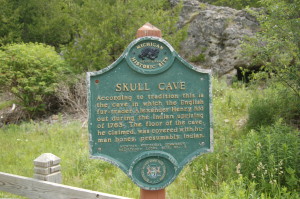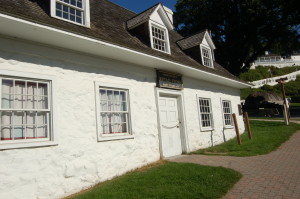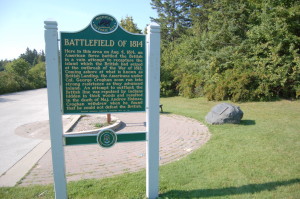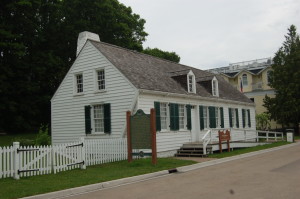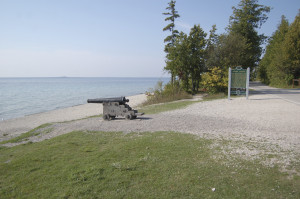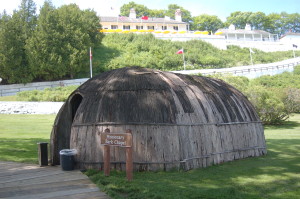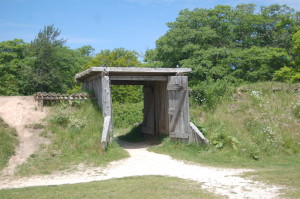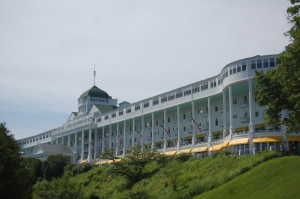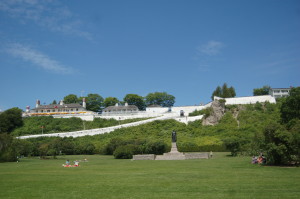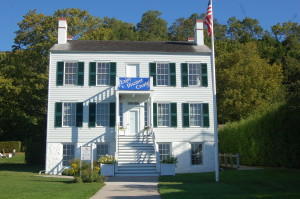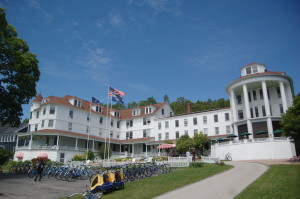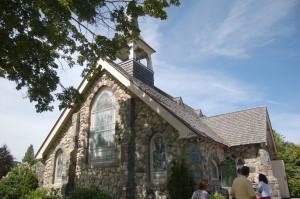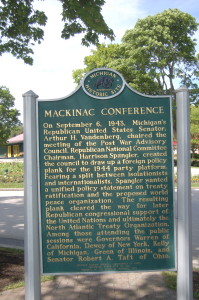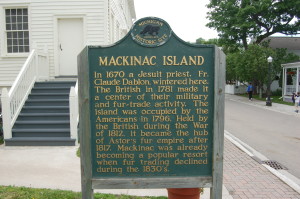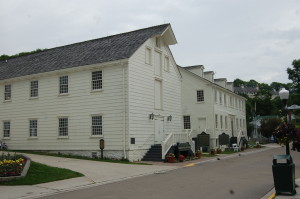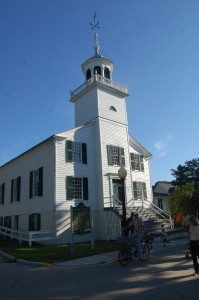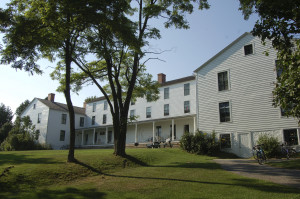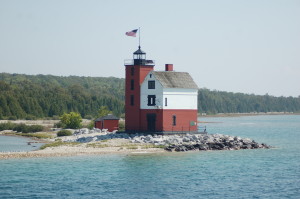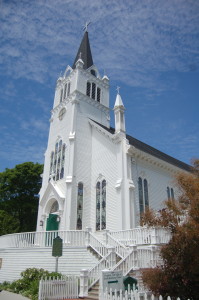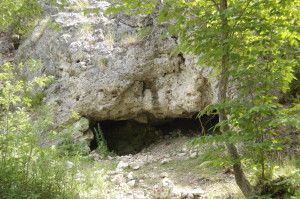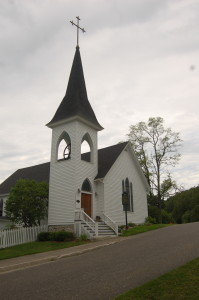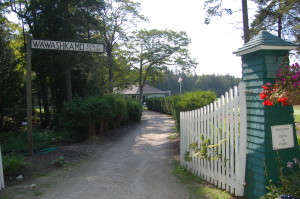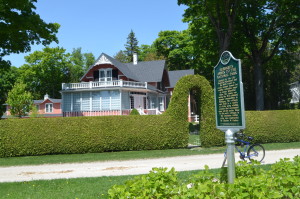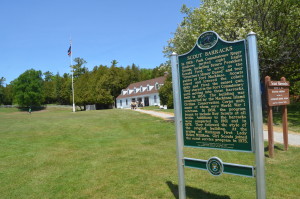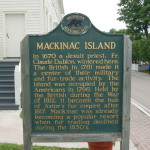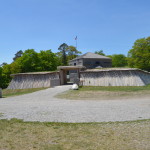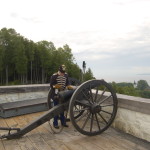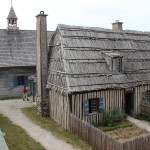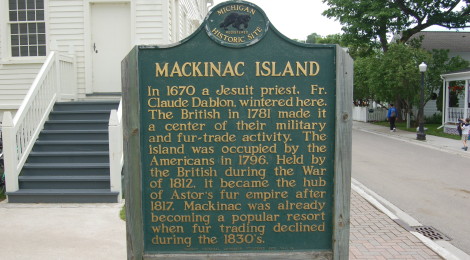
Mackinac Island’s Michigan Historical Markers
Few places in Michigan have a concentration of historical markers like Mackinac Island does. There are more than 20 sites on the island that have been honored with this historic designation, with a few others that either used to have markers, lost their marker due to a change in the historic structure, or have markers that have gone missing. This post will take a look at the sites we’ve had the pleasure of visiting, be sure to check a few out when you make your next trip to Mackinac Island! The book Traveling Through Time by Laura Rose Ashlee was incredibly helpful when trying to find these sites. Some of these sites are among the oldest houses and churches in the entire state, and a few of these markers are among the first handful put in place by the state when the program began in the 1950s.
American Fur Company Store/Beaumont Memorial (Market St.) – “On June 6, 1822, Alexis St. Martin (1804 ~ 1889), a French Canadian, was accidentally shot in the stomach at this American Fur Company retail store. Dr. William Beaumont M.D.(1786 ~ 1853), army surgeon at Fort Mackinac nursed him back to health. Although St. Martin’s physique was not impaired, his stomach wound refused to heal, leaving an opening through which the doctor could observe the digestive process. Beaumont convinced St. Martin to become the subject of a medical study of digestion and wrote several articles on the findings from these experiments. St. Martin married and fathered seventeen children. He out-lived Beaumont by twenty-seven years. The Michigan State Medical Society acquired the retail store in 1947 and, after building this memorial to Dr. Beaumont in 1953, gave the structure to the Mackinac Island State Park Commission.”
Battlefield of 1814 (British Landing Rd.) – “Here in this area on Aug. 4, 1814, an American force battled the British in a vain attempt to recapture the island which the British had seized at the outbreak of the War of 1812. Coming ashore at what is known as British Landing, the Americans under Col. George Croghan soon ran into strong resistance as they advanced inland. An attempt to outflank the British line was repulsed by Indians hidden in the thick woods and resulted in the death of Maj. Andrew Holmes. Croghan withdrew when he found he could not defeat the British.”
Biddle House (Market St.) – “This house is probably the oldest on the island. Parts of it may date from 1780. A deed to the property upon which a $100 down payment was made in 1822 by Edward Biddle was obtained by him in 1827 from the then owner. Biddle was a cousin of the Biddles of Philadelphia and a leading trader and citizen. For years he lived here with his Indian wife. The house is an example of the Quebec rural style. It is listed in the Historic American Buildings Survey and was restored by the Michigan Society of Architects and the building industry in 1959.”
British Landing (on the lakeshore at British Landing Rd.) – “Here, during the night of July 16-17, 1812, a small force of British regulars and several hundred voyageurs and Indian allies from St. Joseph Island landed. They occupied a height that overlooked Fort Mackinac and demanded its surrender. Lt. Porter Hanks, commander of the American garrison of 57 soldiers, had not known that war had been declared. Realizing that resistance was hopeless and might provoke an Indian massacre, Hanks capitulated without a fight.”
Early Missionary Bark Chapel (Marquette Park) – this marker is missing, but the text used to read “According to descriptions by Jesuit missionaries, the bark chapels, which were built among the Indians of the Great Lakes looked like this. In such primitive huts, far from civilization, the courageous French “black robes” lived and sought to turn the minds of the savages to Christianity. One of this illustrious company, Father Claude Dablon, from the mission of Sault Ste. Marie, and later superior general of the Jesuits in Canada, wintered on Mackinac Island in 1670-71 and carried on missionary work here. It is in memory of these heroic pioneer priests that this reconstruction of a bark chapel is dedicated.”
Fort Holmes (Fort Holmes Rd.) – “Here in 1812 on the island’s highest point, a blockhouse and stockade were built by the British and named Fort George. It was the bulwark of British defenses in 1814 when the American attack was repulsed. After the war the Americans renamed the post in honor of Maj. Holmes who was killed during the American assault in 1814. The fort was not maintained by the Americans however. The present blockhouse is not the original building.”
Grand Hotel (on the island’s west bluff) – “Opened on July 10, 1887, the Grand Hotel was built by the Grand Rapids & Indiana and Michigan Central Railroads and the Detroit & Cleveland Navigation Company through the efforts of Sen. Francis B. Stockbridge. It is built of Michigan white pine. With its magnificent colonial porch, longest in the world, it is a classic example of gracious living seldom seen today. One of the outstanding landmarks on the Great Lakes, it is the world’s largest summer hotel.”
Historic Fort Mackinac (Fort St.) – “Mackinac Island has been called the most historic spot in the Middle West. Fort Mackinac was first built by the British in 1780-81. It was not until 1796, thirteen years after the end of the Revolutionary War, that the British relinquished this fort to the Americans. At the outbreak of the War of 1812 the British seized the island and built Fort George. This fort, which you see to the north beyond the Rifle Range, was renamed Fort Holmes by the Americans who reoccupied the island in 1815. Troops garrisoned Fort Mackinac until 1895.”
Indian Dormitory/Henry R. Schoolcraft (Huron St. next to Marquette Park; now the Manoogian Art Museum) – “The Treaty of 1836 transferred 15 million acres of Ojibway (Chippewa) and Odawa (Ottawa) land in Michigan Territory to the federal government. It also required improvements to the Mackinac Island Indian Agency, including a dormitory for Indians visiting the post. This building, designed by Indian Agent Henry Rowe Schoolcraft, was completed in 1838. It was the agency’s administrative headquarters for eight years and occasionally housed Native Americans who came to the island to receive their annual treaty payments. From 1846 to 1867 the building was used for a variety of purposes, including as a U.S. Customs House. In 1867 it became the Mackinac Island Public School, serving in this capacity until 1960. The Mackinac Island State Park Commission purchased it in 1964 and renovated it in 1966.Given the choice, Indian Agent Henry Schoolcraft (1793-1864) moved from the “wild magnificence of nature” at Sault Ste. Marie “back one step into the area of the noisy world” on Mackinac Island in 1833. From the Agency House next door to this site, he continued his lifes work documenting “the history, manners and customs, languages and general ethnology” of Michigan Indians. He first came to Michigan in 1820 as the geologist with the Lewis Cass expedition. In 1822 he became the Indian agent at the Sault. Named commissioner for treating with the Indians in 1836, he insisted on broad tribal involvement in the negotiations. After Schoolcraft left Mackinac for his native New York in 1841, he continued to write and publish research on Michigan Indians that scholars still use today.”
Island House (Huron St.) – “Constructed for Charles O’Malley about 1852, this building was one of the first summer hotels on Mackinac Island. Captain Henry Van Allen, a Great Lakes skipper, purchased the hotel in 1865. He later moved it from the beach to its present location. By the 1880s the Island House was known as “The best family hotel on the island.” Following the death of her parents, Mrs. Rose Van Allen Webster became proprietor about 1892. She was the wife of Colonel John Webster, whom she had met during the 1870s when he was stationed at Fort Mackinac. Mrs. Webster added the large wings in 1895 and 1912, retaining ownership until her death in 1938. The Island House still serves as a resort hotel.”
Little Stone Church (Cadott St.) – “The Union Congregational Church, affectionately called Little Stone Church, was established in 1900 by eleven charter members. Local residents and summer visitors donated funds for its construction. The cornerstone was laid on August 2, 1904. This structure was built of Mackinac Island stones in an eclectic Gothic style. Its handsome stained glass windows, installed in 1914, tell the story of the Protestant movement on the Island. Open only during the summer, this church has been a landmark to visitors and a popular wedding site.”
Mackinac Conference (marker is near Grand Hotel) – “On September 6, 1943, Michigan’s Republican United States Senator, Arthur H. Vandenberg, chaired the meeting of the Post War Advisory Council. Republican National Committee Chairman, Harrison Spangler, created the council to draw up a foreign policy plank for the 1944 party platform. Fearing a split between isolationists and internationalists, Spangler wanted a unified policy statement on treaty ratification and the proposed world peace organization. The resulting plank cleared the way for Republican congressional support of the United Nations and ultimately the North Atlantic Treaty Organization. Among those attending the public sessions were Governors Warren of California, Dewey of New York, Kelly of Michigan, Green of Illinois, and Senator Robert A. Taft of Ohio.”
Mackinac Island (marker can be found on Market St.) – “In 1670 a Jesuit priest, Fr. Claude Dablon, wintered here. The British in 1781 made it a center of their military and fur trade activity. The island was occupied by the Americans in 1796. Held by the British during the War of 1812, it became the hub of Astor’s fur empire after 1817. Mackinac was already becoming a popular resort when fur trading declined in the 1830’s.”
Market Street – “During the peak of the fur trade this street bustled with activity. Each July and August Indians, traders and trappers by the thousands came here with furs from throughout the Northwest. In 1817, John Jacob Astor’s American Fur Co. located its headquarters here. Furs valued at $3,000,000 went through the Market Street offices in 1822. After 1834 the trade moved westward.”
Mission Church (Huron St. near Mission Pt. Resort) – “This is one of Michigan’s oldest Protestant churches. It was built in 1829-30 by the Presbyterian flock of Rev. Wm. Ferry, founder in 1823 of a nearby Indian mission. Robert Stuart and Henry Schoolcraft were lay leaders. About 1838 private owners bought the building. It is judged Michigan’s best example of Colonial church style.”
Mission House (at Mission Pt. Resort) – “In 1823 the Reverend William Ferry founded a Mission on Mackinac Island on the land know known as Mission Point. Two years later he and his wife, Amanda, erected this building as a boarding school for Indian children. In 1827, 112 students attended the school. The majority of the resident pupils were metis, children of Indian and Euro-American parents. The mission closed in 1837. In 1849 Edward Franks opened the Mission House Hotel after adding a third story to the structure. The Franks family operated the hotel until 1939 when it was sold and converted into a rooming house. In 1946 Miles and Margaret Phillimore bought the property, which provided a base for the Moral Re-Armament movement. Around 1971 the Cathedral of Tomorrow purchased the site. Six years later the Mission House became part of the Mackinac Island State Park.”
Round Island Lighthouse (Huron St. south of ferry docks) – “The Round Island Lighthouse, seen south of this site, was completed in 1895. Operating under the auspices of the United States Government, this facility was in continuous use for fifty-two years. It was manned by a crew of three until its beacon was replaced by an automated light in 1924. A sole caretaker occupied and operated the station from 1924 to 1947. Following the construction of a new automatic beacon near the breakwater off the south shore of Mackinac Island, the lighthouse was abandoned. The United States Forest Service now supervises the structure which is located in the Hiawatha National Forest. The lighthouse serves as a sentinel for the past, reminding visitors of the often precarious sailing and rich history of the Straits of Mackinac.”
Saint Anne Church (Huron St.) – “In 1670, Jesuit Father Charles Dablon founded a birchbark mission chapel on Mackinac Island. The following year, Father Jacques Marquette relocated the mission at St. Ignace. Abandoned in 1706 and reestablished at Fort Michilimackinac around 1715, the new church was named Sainte Anne de Michilimackinac. During the winter of 1780 – 1781, British to the island and moved the church building across the ice. The church is the nation’s oldest dedicated to Saint Anne, and maintains baptismal records dating from April 1695.”
Skull Cave (Garrison Rd.) – “According to tradition, this is the cave in which the English fur-trader Alexander Henry hid out during the Indian uprising of 1763. The floor of the cave, he claimed, was covered with human bones, presumably Indian.”
Trinity Church (Market St. at Fort St.) – “Episcopal services on Mackinac Island date from 1837, when a Bishop preached in the Mission Church. For many years the congregation met in the post Chapel at Fort Mackinac and in the Court House. In 1873 a parish was organized, and in 1882 this church building was constructed. Its furnishings include an altar of hand-carved walnut, and two chancel chairs made by soldiers at the fort.”
Wawashkamo Golf Club (British Landing Rd.) – “In 1898 Chicago cottagers founded the Wawashkamo Golf Club. By 1900 the club had been incorporated and the clubhouse had been built on the site of the 1814 Battle of Mackinac Island. Wawashkamo is Indian for “Crooked Trail.” Golf course architect Alex B. Smith left the natural features of the site unaltered in his design for these true nine-hole Scottish links. Wawashkamo Golf Club is Michigan’s oldest unchanged private nine-hole golf links.” *There is also a small plaque on the clubhouse.
Hubbard’s Annex to the National Park (Park Ave. south of Annex Rd.) – “Gordon Hubbard (1802 – 1886) came to Mackinac Island from New England in 1818 to work in the fur trade. His expanding businesses centered on Chicago, where in 1834 he was elected as a town trustee. In 1855 Hubbard purchased this property, building a cottage in 1870. In 1882, Hubbard divided his land into parcels for a summer cottage community. At the time, much of the island was the nation’s second National Park. Inspired by the City Beautiful Movement and the 1880s trend to create summer homes for wealthy urbanites eager to escape industrial cities, the Annex was among the first planned summer communities in Michigan. The cottages were built in a variety of styles along winding avenues that surrounded open private parks. Many of the early cottages in the Carpenter Gothic styles were constructed by Charles W. Caskey.”
Parade Ground/Scout Barracks (behind Fort Mackinac) – Parade Ground: “In the nineteenth century, this area served as a parade ground for soldiers stationed at Fort Mackinac. Here, soldiers practice marching, the manual of arms, bayonet skills and other military drills. By 1843, the parade ground was formally developed and fenced, In the 1870s, several buildings were erected on the edge of the parade ground, including horse stables and housing for non-commissioned officers The parade ground also served as home field for the Fort Mackinac Base Ball Club. Founded in 1885, the club played against other teams from Northern Michigan. In 1887, the team built a grandstand with seating for 500 spectators. An admission to a baseball game cost twenty-five cents, and grandstand seats cost an extra ten cents.” Scout Barracks: “In 1929, Park Commissioner Roger Andrews invited eight Eagle Scouts. including future President Gerald Ford, to serve as the “Governor’s Honor Guard” and tour guides at Fort Mackinac. Scouts raised and lowered the colors daily and fired the sunset gun. They stayed in the Fort Commissary until moving into these barracks, built in 1934. The building was constructed by the Mackinac Island Civilian Conservation Corps unit, many of whom were World War I veterans. In 1938, the program began to include Boy Scouts at all levels. Additions to the barracks were completed in 1975. They followed the style of the original building. At the urging of Michigan First Lady Helen Milliken Girls Scouts joined the scout service program in 1975.”
Other notes on Mackinac Island Historic Markers:
Old Agency House – building and marker removed
British Cannon – marker missing
Lake View Hotel – marker removed after renovations changed the historic structure, hotel has replaced with a blue and white one of their own.

